Childhood memories of 1920s Hong Kong
Primary tabs
Barbara Anslow remembers her childhood in Hong Kong in the 1920s:
1927 - Sailing to Hong Kong with the P & O
Nothing in our village life in Crombie, Scotland had prepared us for the enthralling new world we were entering when we trooped up the gangway on to R.M.S. 'Rawalpindi' [1]. The Redwood family were setting off to Hong Kong where my Dad, an Electrical Engineer, was to work in the Naval Dockyard. Mum was 32, Dad 35, sister Olive 11, Mabel 4, and I was 8.
P & O ships then had black hulls with a single white 'waistline', beige superstructure and black funnels. The top deck sprouted great ventilators and was hung with beige life-boats. My parents had a 2-bed cabin next to the one we girls shared which had double bunks and a single bed, and a narrow corridor leading to the porthole. Each bunk had its own bedside light and mini ventilator which could be twisted to direct the air flow where desired (no air-conditioning then!). On the wall beside the ventilator was a fold-up shelf for the tea and biscuit delivered early every morning. There was a chromium washbasin that folded up when not in use, a small wardrobe and dressing table, the latter having a pullout ledge to use as a desk; also a glass carafe of drinking water.
Children's meals were at different times from the adults' - and the menus...! We children had never before had a choice what to eat, and now indulged ourselves shamelessly, served by Goanese stewards and superintended by English stewardesses in starchy head-dresses and white uniforms whose other duties were tending sea sick passengers.
A Goanese steward walked along the corridors banging a loud gong to summon us to meals - quite unnecessarily as there was always a crowd of children outside the closed saloon door - the moment it opened we raced in to bag the chairs nearest the galley end of the long table.
Daily at 11 am a deck steward toured decks and public rooms offering tiny cups of beef tea and unlimited salty biscuits.
After the mid-day meal, we girls were persuaded to rest in our cabin, especially when we reached warmer climes, but couldn't bear the inactivity long. Children's supper was at 5pm, and our appetites revived during the evenings as we lay awake chatting in bed. The friendly cabin stewards would hand us plates of ice-cream and fruit through the fanlight beside Olive's upper bunk while our parents were dining or socialising.
There was no nursery where parents could plant their children. We children were very unpopular in the public rooms, especially when we occupied a writing desk and wasted the P & O headed note-paper, writing and drawing at will.
With other children on board, we also became constant companions of a small group of soldiers travelling to Hong Kong to join their units; they were not allowed to use the public rooms, so spent all their time on the outside decks, amusing us. The only shop was the Barber's in the First Class accommodation, , but we were rarely taken along those hallowed corridors for haircuts because Mum said 'everything there is a terrible price.'
Memories of our trips ashore at foreign ports are intermingled with those of later voyages - Gibraltar, Port Said, Aden, Bombay, Colombo, Penang and Singapore: just names to us children, places which upset the rhythm and joys of the ship, with meals served at unusual times, an atmosphere of intense heat in the still ship, and an invasion of dusty sweat-smelling coolies humping coal and other supplies along the corridors.
Arriving in Hong Kong, missing home
Early one morning after almost 6 weeks of travelling, the Rawalpindi steamed into Hong Kong harbour, between the rearing green mountains of the island and the more distant ranges behind Kowloon on the mainland. Mum tied a bundle of our old underwear we had been 'wearing out' on the voyage and tossed it into the green treacly sea, from which it was promptly retrieved by a Chinese man on a nearby sampan with his boathook.
Hong Kong from the harbour
Naval Dockyard colleagues met us on the dockside and took us to 'Homeville', a small boarding-house in Happy Valley on the island, where we occupied two ground floor rooms with barred windows overlooking an orange coloured granite mound called Morrison Hill. (In later years 'Homeville' became a Clinic/Hospital.)
We hated the spicy meals provided, and spent most of the time watching out of the windows, missing shipboard freedom. Mum dared not let us go out to play on our own in such an unknown area. It was not a happy time, as she was desperately homesick; Mabel developed enormous blisters all over her body that had to be individually lanced.
My first impressions of Hong Kong are summed up in a poem which began
Where the sun is hot and the earth is dry
And babies wander about like a fly
Is my dwelling-place for quite a few years;
If I stay much longer I shall be in tears.
It's the dirtiest place I've ever seen,
There's no grass like a lovely green.
I'd rather be back in my home in the North
And go for a sail on the River Forth.
Our only excitement was watching blasting operations on Morrison Hill. All day long, dark-clad coolies - men and women - were chipping and hacking away on the site in preparation for blasting. At noon and at 5pm loud gongs would warn that blasting was imminent; we watched in fascination for the puffs of smoke, the explosions, and the flurry of chippings that flew far and wide.
After two weeks we moved to an upper floor furnished flat at 205 Wanchai Road, and made friends with children in adjacent flats. They showed us a game played from their front window on the ground floor: they tied an empty match box to a long piece of thread, then holding one end of the thread threw the box out of the window and sat back watching for a passerby to pick it up, when they would gleefully jerk their end of the thread and haul the box back.
We also made friends with the Grimmit girls, whose house overlooked the side verandah of our flat. We shouted across to each other, negotiating swaps of childish treasures which on settlement we tied to the end of a bamboo pole and swung over to the opposite verandah. We went to Sunday Mass to St. Margaret's, Happy Valley. The Grimmits once took Olive and I to watch the funeral cortege passing nearby of a European woman who had been robbed and murdered.
Mum had a dreadful attack of 'Hong Kong Dog' - a form of food poisoning when she thought she was dying - so did we. She hated Hong Kong more than ever when a burglar entered the flat beneath us via the verandah one night, fortunately confining his activities to stealing several items from the occupant who slept throughout. We learned that burglars in Hong Kong were endemic, and called 'pilo men'.
Settling in
Incredibly, in those days the Naval Dockyard used to ship an employee's household furniture to Hong Kong for a 3-year tour; it came by cargo ship, not on a liner. When our furniture arrived from Scotland, we took a first-floor flat in Cameron Road, Kowloon, a short rickshaw-ride from the Star Ferry. Mum was able to play her piano again, and at last began to settle, especially as we now had a live-in amah, Ah Ng, who did all the cooking, washing and housework.
To try to guard against intruders, we bought a fat brown chow puppy called Scottie who used to squeeze between the balustrades of the verandah and walk along the narrow parapet outside, terrifying us. One day he just vanished - perhaps he escaiped and ended up in someone's chow pot.
We soon became acclimatised to the oppressive heat and the incensy smell of the mosquito coils burning away all night under the beds, but we didn't like the huge cockroaches which could turn up anywhere although they were usually in the kitchen; they flew about at night, banging against the walls and lampshades; there was always a Flit can at hand to fire at them. Less common, but more feared, were centipedes measuring 4 to 6 inches.
Dad bought an electric table fan with a limited steel guard; we were severely warned never to put our fingers inside when it was switched on - but Dad himself was the only victim, and suffered a dreadful cut across the back of his hand - he could have bled to death.
School
The schools had been on summer holiday when we'd first arrived, but eventually it was time for the new term. Olive started at Central British School and I at Kowloon Junior, both within walking distance of Cameron Road.
The old Central British School building today
At Kowloon Junior School there was the constant sound of bagpipes from nearby barracks, but I was only there one term as after Christmas 1927 I graduated with most of my class to the senior school - Central British on Nathan Road. There I felt permanently in a fog, having to learn French and Hygiene (whatever was that, I wondered?) This was my first experience of separate teachers for each subject, and I loved having a different coloured exercise book for each.
Like all the other schools I'd attended, this was a mixed one. For some forgotten reason, one boy in my class was called on to the dais where he was severely caned on his behind - I was so surprised to see a boy howling with pain. There was no school uniform until, in my time there, a pupil called Helen Wylie came to school in a dark blue tussore dress which the Head Master like so much it became girls' uniform.
More interesting than lessons was learning how to 'pick up' and to play 'chucks'. To pick up, two contestants at a given signal brought the hand behind their back forward in one of three positions: either with the palm outstretched which denoted 'paper', with the fist clenched to denote 'stone', and a third position denoting 'scissors'. Scissors could cut paper, paper could enclose stone, and stone could break scissors. The contestants kept on bringing their hands forward until one was defeated by having their weapons neutralised by the other. The reason to win was to have first choice of whatever was on offer.
'Chucks' was a version of Five Stones, but using tiny home-made cloth bags of sand or uncooked rice - we were always trying to make more pliable bags so as to beat our rivals.
Some enterprising pupils ran raffles; the promoter bought ten cheap prizes of various value - usually pencils, rubbers or sweets, and sold tickets for a few cents. Each ticket won a prize, each buyer taking a chance on winning something more valuable than his outlay. The promoter made a small profit as only one or two of the prizes were worthwhile. The idea of making money appealed to me but the enterprise was banned before I could organise my own raffle.
Central British was a Government school, fee-paying, which Mum very much resented. For sports lessons we had to travel on our own on a bus to King's Park which she considered too far away, so Olive and I didn't 'take' sport, and games fees (extras) were thus avoided after she had done battle with the Head Master.
Rickshaws
Mum said if it was raining when it was time to leave school, I could hail a rickshaw, call up to the verandah of our flat when I arrived when she would thrown down the fare. One rainy day when my hopes had been raised then dashed because the rain suddenly stopped, I recklessly took a rickshaw and grandly gave a friend a lift home on the way. Even now I can feel the apprehension with which I crawled out of the rickshaw and called up to Mum for the 10 cents.
I loved the feel of the white tightly upholstered seats. Customers were shielded from rain or sun by a large (collapsible) green hood at the back (as on a pram), and by a green waterproof apron hooked on from one side of the hood to the other. I couldn't see over the apron without pulling it down a bit. When it rained the rickshaw coolies with their conical rattan hats also wore yellow overcoats of palm leaves, making them look enormous When the whole family was travelling by rickshaw, Dad had one to himself, Mum had Mabel on her lap, and Olive and I shared another.
Kowloon life
We moved to a smaller flat in nearby Carnarvon Road; Olive and I shared a bed - a great trial with the extreme heat and suffocating mosquito net; so that we didn't encroach on each other's space, Olive sternly inserted a wooden pole down the middle, poking it through the bars in the bedhead. Being on the ground floor, all our windows were barred against thieves.
Most of our neighbours were Chinese or Portuguese with whom we had no contact - mixing with them wasn't encouraged then; we learned from other children to refer to the Portuguese as 'pork and beans'. Olive and I became friendly with a Jewish family named Salmon, which had daughters about our ages. Frieda and I became bosom friends; I spent as much time in her flat as in our own. Although then 9, I was astonished one day when I called in to find a new baby had arrived.
Frieda and I wandered wherever the fancy took us in Kowloon,or played on the flat roof of our block. The Kowloon roads and streets were not dangerous, there were few cars, mainly buses and rickshaws.
1920s Nathan Road
One of our haunts was Hankow Road near the ferry which had barred money-changers counters; also small shops selling cheap stationery and confectionery - the latter sold at '1 cent 4 sweets' or '1 cent two sweets' depending on size. The shopkeepers were friendly and tolerant of our long, drawn out decision-making, but when you handed over your 5 or 10 cent piece, they always 'rang' it on the counter to test its genuineness.
We knew an Anglo-Indian girl of my age, Gabrielle Larter, who fell from the verandah of her top floor flat while leaning too far over. Her father carried her to a rickshaw which was hurried to the nearest doctor, but she was already dead. She lay in state in her coffin at home for her friends to come and say goodbye to her. (At school in England two years later, when Mabel's class was being taught about the Angel Gabriel, she put up her hand and announced that she had met Angel Gabriel, but was reproved for telling lies. She was most indignant, as Mum had told her at the time of the child's death that Gabrielle was now an angel in Heaven.)
Mabel aged 5 in 1928
A musical family, the Groves, lived near us, with a violinist brother Mr Dark. they played music in the Queen's Theatre at the silent movies, and once memorably got us seats in a box to see 'Rose Marie' with Joan Crawford. Other films we saw were Jackie Coogan, Harold Lloyd and Charlie Chaplin ones; sometimes we were taken to the little Star Theatre off Mody Road in Kowloon to see Mary Pickford films and Our Gang shorts.
Church and First Communion
I was attending weekly sessions at the Italian Convent to prepare for First Confession and First Holy Communion. Most of the other children were Portuguese, Chinese or Eurasian. Good behaviour in class and correct answers were rewarded by distinctive brown hard caramels which the Sisters produced from invisible pockets in their voluminous habits. The preparation concluded with a Retreat during which we were to spend the whole day at the Convent, at prayer and having instruction. No meals were provided, so Mum told me to be at the Convent gates at lunch (then called 'tiffin') time to receive a hot meal Ah Ng would bring me. This I did, but when I found that no chips were included in the dish, I marched back home to get some - though vaguely aware that this wasn't in keeping with the spirit of the Retreat.
Barbara aged 9 in 1928
Mum made me a short white dress for the great day; I wore a large plain veil and carried an enormous candle since Confirmation was to take place at the same time. Rosary Church was always packed, mainly with Portuguese and Chinese the latter plying their hand fans furiously. It was grossly overcrowded that First Communion Sunday with relatives and friends lending support to we children in the front pews. We knew our cue for walking to the altar to receive Holy Communion - the Sister in charge would snap the wide black elastic band which was round her prayer book.
Crossing the harbour
Crossing the harbour was always an adventure. Once the ticket collector would not let Mum pay for a ticket for me, saying 'under 6 no pay' though I was then 9. Ferries ran every few minutes, the next one would be lying off the pier as the present one pulled away. The rails of the upper deck (where we travelled) were lined with lifebelts, the seats reversible. Delivery coolies and many Chinese travelled on the cheaper lower deck which seemed only inches away from the water.
As your ferry drew alongside the pier, a Chinese in sailor's unifom started to let down the gangway on the upper deck; it was quickly pressed into position on the pier by passengers eager to get off quickly. Once, waiting to disembark, we were horrifid spectators when on the deck below a Chinese woman with a baby strapped to her back leapt from the side of the boat to the lower landing stage, missed, and fell between ferry and pier. A ferry sailor jumped in at once and rescued her before she could drown or be squashed between ferry and pier.
Shops and Shopping
We were now enjoying life in the colony; one of the delights to us girls was having lemonade every day, even though we had to share a bottle between us. The bottles were kept in our ice-box, great lumps of ice being brought regularly from the Dairy Farm Ice & Cold Storage Company by a coolie who carried across his shoulders a bamboo pole on each end of which was suspended ice gripped by giant hooks. A distinctive smell of coldness and food wafted up from the tin-lined chest every time the lid was opened. We also had a meatsafe - a meshed cupboard standing on legs each of which sat in a small china bowl full of water to discourage invading ants. Another piece of equipment new to us was a large china water filter - we were told never to drink water direct from the kitchen tap.
Mum bought meat and vegetables daily in the Market. Dry goods and groceries were delivered daily by a boy from the firm Shui Tai - your supplier was known as 'the compradore.' We always used tinned milk, there weren't many cows in Hong Kong then.
We often went to the curio shops with Mum, who was attracted by all things oriental; after lengthy bargaining she acquired a blackwood music cabinet with many drawers, a set of teapoys and a carved piano stool, all of which served us for years. These shops had so many things of interest to us: figurines of Chinese buddhas, each on his own little blackwood stand; rows of ivory elephants of rising sizes carved out of a tusk; ivory balls with filigree carving within which a smaller carved ball rotated, and within that ball was yet another; jade ornaments, snuff bottles. Mum bought a tiny imitation Chinese grave, the front of which could be pulled up when out sprang a little Chinese coffin; cloisonne vases, ginger jars, and a small silver (looking) rickshaw with puller, a junk, and a sedan chair with carrier at either end. Mabel told me recently that as a child she thought these models were real silver and very valuable, and secretly made up her mind that if ever our house caught fire, she would grab them and bring them to safety.
We also visited the camphorwood shops, all next door to each other in Wanchai where you could buy all sizes of trunks and bureau-type desks, exuding the pungent sell of camphor as well as the delicate odour of the sandalwood used inside for fitted trays. (For my 21st birthday my colleagues at work gave me the most beautiful camphorwood bureau which of course was lost with all our furniture during the war.)
Also in Wanchai was the Japanese shop, Daibutsu's.
Daibutsu, at the junction of Queen's Road East & Arsenal Street
As well as the Japanese figures in traditional costume, they sold fascinating wooden puzzles. One consisted of wooden oblongs apparently dove-tailed together, but should you push the correct oblong it moved out of its niche and you could gradually dismantle the whole thing. Each of us girls had a traditional Chinese doll with pigtail, dressed in bright silk jacket and trousers; the dolls' heads, hands and feet were made of some sort of plaster, the rest of the body was stuffing.
Student becomes teacher
I started to teach Ah Ng to write English - an ambitious project since she couldn't speak much English and couldn't write Chinese. She patiently covered pages of an exercise book with a's and b's and c's, and learned to print the word 'cat' before her enthusiasm (and mine) waned. Mum, when going through the monthly bills, found the word 'cat' carefully printed on a receipt for our groceries - apparently the delivery had arrived while only Ah Ng was home, 'so I lite all same Missie Bubla talkee me' she told Mum proudly.
Living on Hong Kong island
The Salmon family moved from Kowloon to the island - to the very house where we Redwoods had first lodged, No.205 Wanchai Road. Mr. Salmon ran a rattan-furniture business on the ground floor and the family lived on the upper floors. Soon we too moved to the island - I don't know why: maybe because the Dockyard was there, also the tennis courts; perhaps because my parents had decided to take us away from Central British School and enrol us at the Garrison School on the island where no fees were payable!
Our new home was a ground floor flat at 98 Kennedy Road, in a small terrace reached by many flights of steps beside which ran a large nullah. There was a sliding concertina iron gate which could be locked across the main entrances at night. A little yard behind linked our flat with the amah's tiny quarters. On the only floor above us lived a dockyard family, Mr and Mrs Harper and Joyce (13) and Brian (4). In the flat next to ours lived the Penneys, also a Dockyard family with their daughter Ena (14). The rest of the flats in the terrace were occupied by Portuguese and Chinese families with which we didn't mix.
Rearing above Ah Ng's room was a vertical hillside which we climbed up to reach a rough path; one way wound round the hillside towards Happy Valley, passing earthenware jars containing (we were told) the bones of departed Chinese. Once my friends and I decided to look in one of the jars, but after begnning to dislodge the lid, we hastily replaced it when huge black beetles emerged. In the other direction, the path towards Central led to a muddy pool fed by rainwater cascading down the hillside from nullahs. Small Chinese urchins sometimes played in the pool.
Recreation - tennis, films, swimming, and trips on a launch
The Naval Dockyard tennis courts on the island were available for employees' families and Mum played there regularly, sometimes taking Mabel who made two new friends of her own age: George Kirman and Francis Crabbe. (Who would have dreamed then that 12 years later George would become Mabel's first boyfiend - a very brief romance as he was young enouigh to be evacuated from Hong Kong to Australia with his mother in 1940? Or that Francis and his wife would become neighbours at King's Park, Kowloon and great friends with Mabel and her husband in the 1950's ?)
Some evenings our parents took us to films (silent of course) on HMS 'Tamar', an old wooden-topped Naval vessel permanently tied up in the Dockyard and used as Fleet Accommodation Barracks. I can feel now the breeze from the overhead punkas, the mid-darkness, and the grownup films which didn't interest us children. Here Mabel once asked Mum 'Why does that man keep smelling the lady's hand?'
Naval Yard showing tennis courts and HMS Tamar
Bathing trips organised by the Naval Yard were the main delight of our time in Hong Kong. Every Tuesday and Thursday after office and school hours, a small launch took us the ten minute trip to Stonecutters Island in the harbour and anchored near the beach. Strong swimmers jumped overboard and swam to the beach; the less able like Mum and us girls, were rowed ashore in the launch's dinghy.
Every weekend, alternately on Saturday or Sunday, there was an afternoon trip on a larger launch, the OC409, to one of the further beaches - Big Wave Bay, Island Bay, Deep Water Bay, Silvermine Bay, Cheung Chau (this last not our favourite, as the silver beach was spoilt by having huge quantities of smelly fish drying out to end up in fish paste factories.)
Launches at Repulse Bay
We boarded the OC409 in the Dockyard when it eased along the stone steps; a small white sampan in the adjacent boathouse was hauled over the log which prevented craft from drifting from the enclosure: one sunburnt coolie stood on the log to keep it sufficiently below the surface of the water to enable a second coolie to prod and tug it over the boom; then it was tied behind the OC409 as an addition to the tiny lifeboat suspended from the deck.
Ladies occupied round wicker chairs in the bow, men at the stern; teenagers and flappers in between, some lounging on the less hot areas of the engine casing playing their banjos and singing 'Ain't She Sweet' and 'Bye Bye Blackbird.' Children belonged nowhere in particular and ranged about everywhere.
A tarpaulin roof kept out the worst of the heat, but it was always a glorious relief when the launch nosed out of the Dockyard basin and chugged across the harbour, bringing welcome breezes, on its way to pick up the 'Kowloonites.'
On our first bathing trip, being unused to the power of the sun, Mum stayed too long on the beach and was terribly sunburnt; her shoulders came up in huge blisters and looked like the top of a tapioca pudding. She couldn't bear any clothing on them, and had to go to see the doctor with her petticoat and dress tied up beneath her armpits.
Most of the glorious beaches were about an hour's sailing away, some reachable only by sea - often the OC409 was the only launch there, and the beach empty except for fishermen mending their nets. We children were lent large white solid ships' lifebelts - Olive and I (and Mum) all learned to swim with their help. Dad (in his swim suit with a skirt!) could already swim.
A long white unsinkable cork pole, called 'the sausage', provided us with endless fun, especially when an indefatiguable soul called Mr Moore used to assemble us along its length, then, with him at the front, we propelled it along by using our arms as paddles. The afternoon over, the launch's siren summoned us aboard. Long after we small fry had been rowed back and scaled the vertical ladder, the young lions were cavorting in the water, diving from the ship's diving board or plunging down the water chute drenching our admiring faces.
We young girls changed in a tiny forward cabin; it was a dreadful struggle to peel off our wet thick woollen costumes and get into our clothes. Talcum powder didn't help much. On the homeward trip we devoured sandwiches we'd brought in the Hong Kong-made small wicker baskets. Tea was brewed amidships by the Chinese 'boys'. Minerals were sold on board; there was a constant whining from children for 'ten cents for another lemonade.' We Redwoods knew it was no good pestering Mum or Dad for more once we had had our ration but how we envied the select few who seemed to be forever wandering along the deck with a newly-opened bottle of Watson's.
From April to October each year the OC409 became our Mecca. We all - adults and children - wore topees during the summer season, mostly white ones with green lining. On one bathing trip, Mabel's topee blew off her head into the sea; the launch turned about, chasing the floating topee until one of the crew was able to rescue it with his boat hook: of course our OC409 would not sail on and abandon a little girl's hat!
Darker news
Even we children were aware of troubles in distant Canton, of killings and famine. Mum bought postcards showing cartloads of Chinese corpses. She persuaded me to hand over a prized little doll to Chinese friends of Ah Ng who had told her dreadful tales of hardship in China, in stark comparison with our supremely happy lives.
The Garrison School
We 3 girls started at the Garrison School, near the Peak Tram Lower Terminus, which was mainly for Army childen, the Head Master being an Army Officer. Althogh we could reach the school by a 20-minute walk along Kennedy Road, this was a lonely area with few buildings; walking that distance in the hot sun would be trying, and Mum would have had to take us back and forth each day. Instead, we went to school by snorting, orange Vulcan buses which ran on the lower Queen's Road.
To reach the bus stop we walked down a smelly short steep street of Chinese tenements and shops, with a deep nullah in the middle. We did this by ourselves, Olive then 12 being in charge of Mabel now 5. Olive had a problem getting up early enough for the appropriate bus, so I often journeyed on my own, sometimes walking the bus route and pocketing the fare for sweets. Our favourite bus was one with the mispelt notice above the inside door saying 'When alighting, wail until the bus stops.'
The school was a one-storeyed building. Most of the rooms housed two classes. For coolness they had full-length windows the lower half of which had frescoed iron bars; if the teacher let the room for a moment, some of the boys used to climb out of the winows just for the hell of it.
At playtime we played 'release', or ran to what was known as the Ball Alley - presumably originally an Army badminton hall - no longer in use and a bit of a ruin; it was adjacent to the school and strictly out of bounds, but we used to race through it and play unremembered hectic games there.
We took sandwiches for 'tiffin'; sometimes I walked down to the Naval Dockyard with the George Twins, Peggy and Winnie, who lived in Kowloon and whose tiffin was brought to them by launch every day. Their food arrived hot in a tiered aluminium canister which looked very superior to my pack of sandwiches, but we often swapped food; the twins always wore white pinafores over their dresses.
Sometimes we wandered down Battery Path to a sweet shop called the 'Boston' in Queen's Road. Of course, the day the King Edward Hotel in Central burned down, we were there in force as soon as we were free, trying to get as near to the scene as possible and listen to the ghoulish stories arising from the tragedy, in which several lives were lost.
A roofless King Edward Hotel building after the fire
Learning music
When we'd lived in Kowloon, Olive and I had music lessons from Jean Braga, one of a large well-known Portuguese family living in Kimberley Road near our flat. The youngest, Mary, was in her teens; Caroline, a little younger than Jean, was already a gifted pianist; one of the brothers, handsome John, was a prize violinist. Neither Olive nor I were very keen on music, but the sessions had other attractions, as Jean had many pupils and we could arrive as early as we liked and play in the garden below the house until lesson time. (Remember we had no gardens as we lived in flats.) All the Bragas made us very welcome; we were invited to a family party there, with marvellous parlour games in which all the adults joined with enthusiasm.
After we moved to Hong Kong side, Jean held our lessons on Saturdays in what was then the Victoria School near Happy Valley. Walking there for my lessons in 1929, I could not have dreamt that 25 years later I would be walking that same path to pick up the Government bus when it was my turn to chaperone the Happy Valley children (our own included) to Quarry Bay School - Victoria School was no more, the site had become a Government Transport Depot.
I managed to scrape a pass in First Steps piano exam. Olive did much better in her violin exam.
Memorable parties
Olive's prowess on the violin meant she was selected to play in a concert at Government House during a children's party there. As a sister of a performer, I was allowed to the party too.
There was another memorable party - on H.M.S. Cumberland tied up alongside the Naval Dockyard. Everywhere were helpful sailors, and coloured bunting. We had never had such 100% entertainment - lots of games, plenty to eat.
In one corner there was an enormous painted face with huge open grinning mouth; we were invited to feed shovelfuls of nails into the mouth, but very few nails actually got there - they flew to the lips which had been magnetised. But the chief attraction for me was a barrel of water at the bottom of which lay a number of Hong Kong coins; you could put your hand and arm down into the water and try to pick up a coin, but the water was slightly electrified so it took courage to leave your hand in long enough to get your prize. I was used to mild electric shocks as Dad had demonstrated them to us, so I decided to keep on getting coins until I had enough to buy a little printing set I craved at the time.
(Olive and I each received $1 a month pocket money, but mine was usually borrowed well in advance)
Out and about
Although Frieda Salmon and I were no longer at the same school (she remained at Central British and went on to Hong Kong University), I still visited the family in Wanchai road, usually taking a short cut from Kennedy Road by climbing over Morrison Hill - but not at blasting times!
I went out selling poppies one Armistice Day, wearing a bright red dress Mum made for the occasion. When I learned that poppy sellers could use public transport free that mornng, I made the most of it by taking the bus as far as the Vehicular Ferry, which took me to Yaumati, an area of Kowloon then not much frequented by Europeans. Here an English policemen gently told not to stay there and ushered me back on to the ferry.
Our nearest church to 98 Kennedy Road was St. Joseph's on Garden Road. With Mum we walked along Kennedy Road from where you looked down on the harbour and tenements and shops, then the red-brick blocks of army flats, past the residential block later known as 'Courtlands' (That block may not then have been the guesthouse it had become by 1939 when I often visited a friend there. By 1949 'Courtlands' had become Government Flats - Frank and I had our first home there in a top floor flat. )
Looking down to Kennedy Road & the Army Flats
A Chinese wedding was held in a large house near our terrace; seeing us watching from a vantage point on the terrace, an English-speaking Chinese lady invited Mum and us girls to the ceremony, and we found ourselves ranged on hard chairs round a large room. With a background of fire crackers and timpany, food and Chinese tea were constantly pressedon us, the latter had a sort of nut floating in it. We were told it as a 'happiness nut', but it was almost impossible to bite properly. At an appointed time the little bride, overloaded with traditionl colourful wedding costume with beading hanging over her face, was carried in piggy-back by an amah. I didn't like the raw Chinese tea (without milk or sugar) so drank it quickly to get rid of it, but courtesy demanded that a new cupful replace the empty one immediately. I couldn't wait to get home.
Hong Kong goes thirsty
There were no serious typhoons while we were in Hong Kong, but there was a dreadful water shortage for months and months on end; even we children were aware of the seriousness of it, hence a poem that began
'In Hong Kong there's hardly any water,
And the taps are turned off many times a day,
And the great big steamers that are in the harbour
Bring water from some places far away.
And every morning when you read the paper
'Do Not Waste The Water' s always there,
So when you go to turn the tap on, please remember
Those two great precious words 'Take Care'.
1929 - Time to leave
In the summer of 1929 Mum told us children that we were leaving for England within a few weeks: my Father's health had become a source of anxiety and the doctor had forbidden him to carry on for the last year of his tour. The prospect of the ship journey quickly compensated for leaving our lovely life Hong Kong. A host of friends came to see us off on RMS 'Rajputana' [2], including the Kirmans, whose little son George got lost on board, resulting in frantic searchings as the All Visitors Ashore gong sounded. It transpired he had gone ashore on his own via another gangway. As the ship moved out from the dock where our amah Ah Ng was weeping abjectly, the heavens opened - the water shortage was over,
On board we made friends with some children from Shanghai - Hugh Cruttwell, his little sister Margery and Hugh Pawsey; the boys were about my age and always seemed rather superior though travelling second class as we were.
A little group of servicemen was travelling Home, and as on the outward voyage, provided us children with hours of fun and amusement. One was rather a show-off. While our parents were watching a mad deck game of Follow My Leader, we kids were vainly trying to keep up with this particular sailor, who vaulted over bollards too high for us When it was my turn to lead, Olive hissed in my ear 'Go and kiss Mum!' - which I did: as Olive guessed, the sailor dared not do the same.
At Singapore we taxied to the Botanical Gardens and admired the antics of the monkeys. At Penang we watched gold ingots being piled on the wharf for shipment and wondered why they were not stolen - until Mum tried to lift one.
In between ports, we played 'Sardines' (taught to us by the Hughs) during which we ranged the ship and hid in baths, much to the rage of the Goanese bath stewards. We went ashore at Marseilles; my memory is not of the city, but of the hot night when the ship lay against the dockside. From my porthole I saw a woman of arresting appearance standing on the wharf singing, slowly and pathetically, as if her existence depended on the pittance she hoped to receive for her haunting song.
On arrival at Tilbury, Dad had a message saying he would be stationed at Sheerness Dockyard, Kent. Sheerness is only a 45minute train ride from Gillingham, where our Granny and Aunt and Uncle lived - we were all so delighted!
In our new life in England, Hong Kong was gradually forgotten - until 9 years later when Dad was again appointed there so back we all went.
Thanks to Barbara for sharing these priceless memories. Barbara was in Hong Kong in 1941 when the Japanese invaded. She spent the next 3 years and 8 months interned by the Japanese at Stanley Camp. You can read about those experiences in her wartime diaries, which she has also generously posted here for us to read.
If you can add any of your own memories of the people and places that Barbara describes, please let us know in the comments below.
Regards, David
References:
- A postcard showing the SS Rawalpindi, and additional information about the ship can be seen at http://www.warcovers.dk/greenland/amc_rawalpindi.htm
- The SS Rajputana: http://en.wikipedia.org/wiki/SS_Rajputana


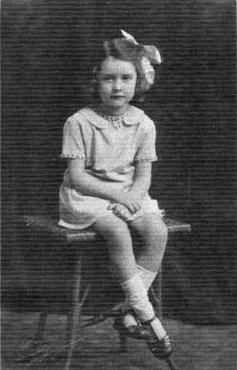
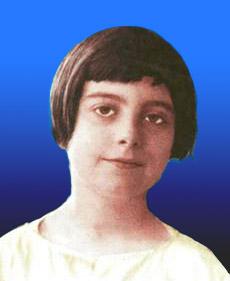
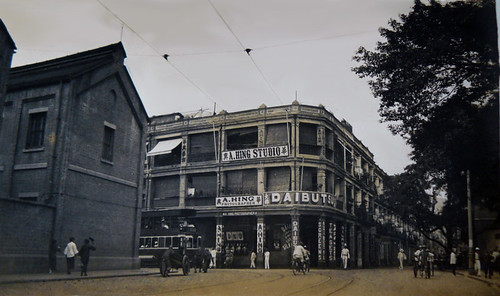
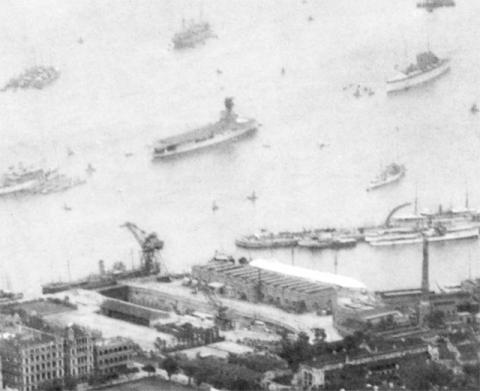
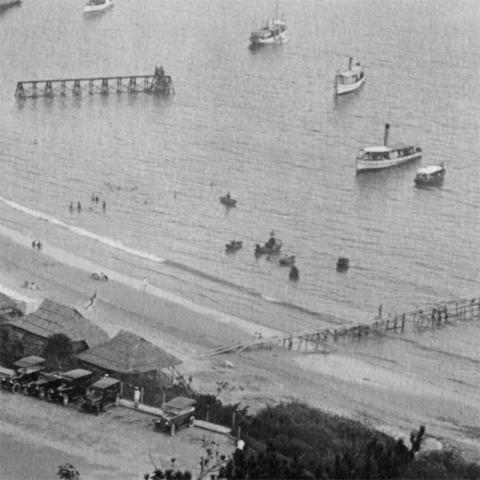
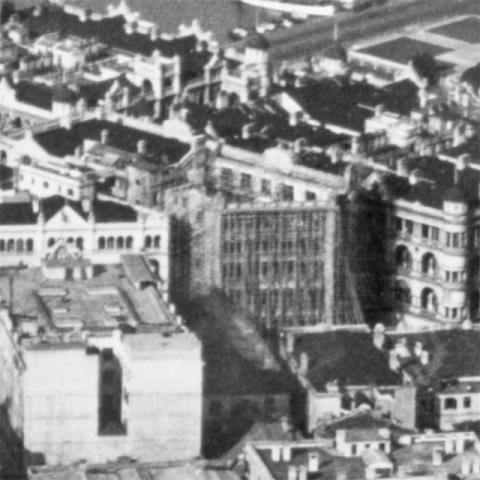
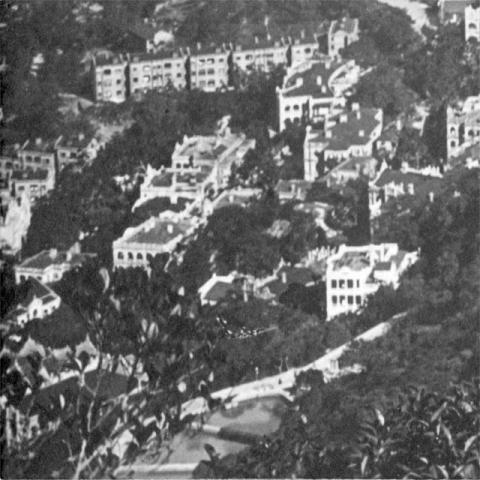

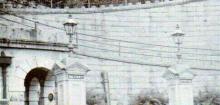
Comments
RAWALPINDI
Captain Kennedy of the Rawalpindi after she had been converted to an armed merchant cruiser was the father of famous broadcaster and journalist Ludovic Kennedy.
Extra notes from Barbara
Thanks to Barbara for these extra clarifications:
A 1910s postcard of Stone Nullah Lane below Kennedy Road:
That Stone Nullah Lane certainly looks very familiar, I'm sure that would have been the street I refer to in memoirs, although in my memory the shops were more built up, that would probably have happened since your photo was taken. I can't specifically remember the incense ((from the temple on the right)), I think the other smells were so intense! As far as I can recall, from the rows of steps leading from our flat in Kennedy Road, we just crossed Kennedy Rd and almost at once came to the smelly road downhill to Queen's Road.
1930s Photos
Photos received as is.
S. S. Rajputana, sister ship to the Rawalpindi.
Kowloon Junior School Pupil on Rickshaw on Austin Road, Kowloon
OC409 at Stonecutters Island
Naval Yard Tennis Courts
Deep Water Bay
HMS Cumberland
Dairy Farm Ice and Cold Storage Building (on the left) corner of Humphreys Avenue and Nathan Road
Childhood games
In case anybody is interested in this game, the following is an account I can recall:
Chucks" is known as "grab piece" (pronounced as "wah ji" in Cantonese). The game can be played by 2 or more children. The pieces are small cloth bags, about 1" x 1" x0.5", containing raw rice, made by older children / their mother. The game is played on the floor, with the children sitting around a circle. To start the game, the player holds all 5 pieces with one hand, throws them in the air, and as they fall, puts the back of his/her hand in the path and scatter them, to make sure the pieces are separate from one another. The child then picks up one of the 5, throws it in the air, and grab one of the other 4 before catching the falling piece. He/she must catch the falling piece so that he/she now should have 2 pieces in his/her hand. If he/she can do this without moving the other 3 pieces on the floor, he/she now proceeds the procedure for all the pieces on the floor, carefully avoiding moving any other piece while doing so. If he/she accidentally move another piece while performing the grabbing action of one piece, or if he/she fails to catch the falling piece before grabbing the piece on the floor, he/she loses, and the game is over! After each child has successfully performed this action (picking up each of the 4 pieces one by one without moving other pieces) , the action is repeated at the 2nd level - when the child now grabs 2 pieces while throwing up one piece, and then catch the falling piece successfully. With 2 trials, he/she will finish grabbing all 4 pieces. The 3rd level involves grabbing one piece on the floor, and then all 3 remaining pieces on the floor each time a piece is thrown into the air. (Alternatively, he/she can pick up 3 first, and then the remaining one piece.) The 4th level involves grabbing all 4 pieces while throwing one piece into the air. The trick is not to scatter the 5 pieces too far while one is at the higher levels, so that there is sufficient time to grab several pieces at once. The cons however, is that if the pieces are too near to one another, there is a higher chance of touching the unintended pieces while picking up the piece(s) one intends to pick up.